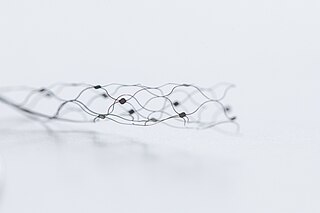Related Research Articles

A brain–computer interface (BCI), sometimes called a brain–machine interface (BMI) or smartbrain, is a direct communication pathway between the brain's electrical activity and an external device, most commonly a computer or robotic limb. BCIs are often directed at researching, mapping, assisting, augmenting, or repairing human cognitive or sensory-motor functions. They are often conceptualized as a human–machine interface that skips the intermediary component of the physical movement of body parts, although they also raise the possibility of the erasure of the discreteness of brain and machine. Implementations of BCIs range from non-invasive and partially invasive to invasive, based on how close electrodes get to brain tissue.
BrainGate is a brain implant system, currently under development and in clinical trials, designed to help those who have lost control of their limbs, or other bodily functions, such as patients with amyotrophic lateral sclerosis (ALS) or spinal cord injury. The Braingate technology and related Cyberkinetic’s assets are now owned by privately held Braingate, Co. The sensor, which is implanted into the brain, monitors brain activity in the patient and converts the intention of the user into computer commands.

Miguel Ângelo Laporta Nicolelis, is a Brazilian scientist, physician and Duke School of Medicine Professor in Neuroscience at Duke University, best known for his pioneering work surrounding brain-computer interface technology.
Brain implants, often referred to as neural implants, are technological devices that connect directly to a biological subject's brain – usually placed on the surface of the brain, or attached to the brain's cortex. A common purpose of modern brain implants and the focus of much current research is establishing a biomedical prosthesis circumventing areas in the brain that have become dysfunctional after a stroke or other head injuries. This includes sensory substitution, e.g., in vision. Other brain implants are used in animal experiments simply to record brain activity for scientific reasons. Some brain implants involve creating interfaces between neural systems and computer chips. This work is part of a wider research field called brain–computer interfaces.
Neuroprosthetics is a discipline related to neuroscience and biomedical engineering concerned with developing neural prostheses. They are sometimes contrasted with a brain–computer interface, which connects the brain to a computer rather than a device meant to replace missing biological functionality.
Neural engineering is a discipline within biomedical engineering that uses engineering techniques to understand, repair, replace, or enhance neural systems. Neural engineers are uniquely qualified to solve design problems at the interface of living neural tissue and non-living constructs.
Bio-mechatronics is an applied interdisciplinary science that aims to integrate biology and mechatronics. It also encompasses the fields of robotics and neuroscience. Biomechatronic devices cover a wide range of applications, from developing prosthetic limbs to engineering solutions concerning respiration, vision, and the cardiovascular system.
Neuroinformatics is the emergent field that combines informatics and neuroscience. Neuroinformatics is related with neuroscience data and information processing by artificial neural networks. There are three main directions where neuroinformatics has to be applied:
In neuroscience, single-unit recordings provide a method of measuring the electro-physiological responses of a single neuron using a microelectrode system. When a neuron generates an action potential, the signal propagates down the neuron as a current which flows in and out of the cell through excitable membrane regions in the soma and axon. A microelectrode is inserted into the brain, where it can record the rate of change in voltage with respect to time. These microelectrodes must be fine-tipped, impedance matching; they are primarily glass micro-pipettes, metal microelectrodes made of platinum, tungsten, iridium or even iridium oxide. Microelectrodes can be carefully placed close to the cell membrane, allowing the ability to record extracellularly.
Neuroergonomics is the application of neuroscience to ergonomics. Traditional ergonomic studies rely predominantly on psychological explanations to address human factors issues such as: work performance, operational safety, and workplace-related risks. Neuroergonomics, in contrast, addresses the biological substrates of ergonomic concerns, with an emphasis on the role of the human nervous system.
NeuroArm is an engineering research surgical robot specifically designed for neurosurgery. It is the first image-guided, MR-compatible surgical robot that has the capability to perform both microsurgery and stereotaxy.
Microelectrode arrays (MEAs) are devices that contain multiple microelectrodes through which neural signals are obtained or delivered, essentially serving as neural interfaces that connect neurons to electronic circuitry. There are two general classes of MEAs: implantable MEAs, used in vivo, and non-implantable MEAs, used in vitro.

OpenViBE is a software platform dedicated to designing, testing and using brain-computer interfaces. The package includes a Designer tool to create and run custom applications, along with several pre-configured and demo programs which are ready for use.

The neurotrophic electrode is an intracortical device designed to read the electrical signals that the brain uses to process information. It consists of a small, hollow glass cone attached to several electrically conductive gold wires. The term neurotrophic means "relating to the nutrition and maintenance of nerve tissue" and the device gets its name from the fact that it is coated with Matrigel and nerve growth factor to encourage the expansion of neurites through its tip. It was invented by neurologist Dr. Philip Kennedy and was successfully implanted for the first time in a human patient in 1996 by neurosurgeon Roy Bakay.
Frank H. Guenther is an American computational and cognitive neuroscientist whose research focuses on the neural computations underlying speech, including characterization of the neural bases of communication disorders and development of brain–computer interfaces for communication restoration. He is currently a professor of speech, language, and hearing sciences and biomedical engineering at Boston University.

Stentrode is a small stent-mounted electrode array permanently implanted into a blood vessel in the brain, without the need for open brain surgery. It is in clinical trials as a brain–computer interface (BCI) for people with paralyzed or missing limbs, who will use their neural signals or thoughts to control external devices, which currently include computer operating systems. The device may ultimately be used to control powered exoskeletons, robotic prosthesis, computers or other devices.
A cortical implant is a subset of neuroprosthetics that is in direct connection with the cerebral cortex of the brain. By directly interfacing with different regions of the cortex, the cortical implant can provide stimulation to an immediate area and provide different benefits, depending on its design and placement. A typical cortical implant is an implantable microelectrode array, which is a small device through which a neural signal can be received or transmitted.

A mind-controlled wheelchair is a motorized wheelchair controlled by a brain–computer interface. Such a wheelchair could be of great importance to patients with locked-in syndrome (LIS), in which a patient is aware but cannot move or communicate verbally due to complete paralysis of nearly all voluntary muscles in the body except the eyes. Such wheelchairs can also be used in case of muscular dystrophy, a disease that weakens the musculoskeletal system and hampers locomotion.

Neuralink Corp. is an American neurotechnology company that is developing implantable brain–computer interfaces (BCIs), based in Fremont, California, as of 2024. Founded by Elon Musk and a team of seven scientists and engineers, Neuralink was launched in 2016 and was first publicly reported in March 2017.
Precision Neuroscience is an American brain–computer interface (BCI) company based in New York City and with offices in Mountain View, California, Addison, Texas and Minneapolis, Minnesota.
References
- ↑ NZZ- Die Zangengeburt eines möglichen Stammvaters. Website Neue Zürcher Zeitung. Seen 16. August 2013.
- ↑ Official Homepage Roboy Archived 2013-08-03 at the Wayback Machine . Website Roboy. Seen 16. August 2013.
- ↑ Official Homepage Starmind. Website Starmind. Seen 16. August 2013.
- 1 2 Miranda, Robbin A.; Casebeer, William D.; Hein, Amy M.; Judy, Jack W.; Krotkov, Eric P.; Laabs, Tracy L.; Manzo, Justin E.; Pankratz, Kent G.; Pratt, Gill A.; Sanchez, Justin C.; Weber, Douglas J.; Wheeler, Tracey L.; Ling, Geoffrey S.F. (2015-04-15). "DARPA-funded efforts in the development of novel brain–computer interface technologies". Journal of Neuroscience Methods. 244: 52–67. doi: 10.1016/j.jneumeth.2014.07.019 . ISSN 0165-0270. PMID 25107852.
- ↑ "Brain Computer Interface Market Size Report, 2020-2027". www.grandviewresearch.com. Retrieved 2021-04-14.
- ↑ May 16; Orenstein 401-863-1862, 2012 Media contact: David. "People with paralysis control robotic arms using brain–computer interface". news.brown.edu. Retrieved 2021-04-14.
{{cite web}}: CS1 maint: numeric names: authors list (link) - ↑ "The Machine That Reads Your Mind (Kinda) and Talks (Sorta)". Wired. ISSN 1059-1028 . Retrieved 2021-04-14.